The Willi Hennig SocietyTwelfth International workshop in Phylogenetic Methods |
|
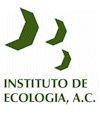  |
23
- 27 May, 2011.
Instituto de Ecologia, AC. Xalapa, Ver (México). |
The Willi Hennig SocietyTwelfth International workshop in Phylogenetic Methods |
|
  |
23
- 27 May, 2011.
Instituto de Ecologia, AC. Xalapa, Ver (México). |
| PARTICIPANTS | |
| AT THE PHYLOGENETICS WORKSHOP | |

|
Dr. Leandro Assis. UNIVERSIDADE DE SAO PAULO (BRAZIL). My research is addressed to the systematics of the Neotropical Lauraceae (i.e. the laurel and avocado family). Currently, I am developing a post-doctoral project at Universidade de São Paulo, Brazil, concerned with the phylogenetic relationships of the Ocotea complex – a predominantly Neotropical clade composed by14 genera and about 700 species – based on morphological and molecular evidence, and the homology assessment of the stamens and microsporangia within the clade through ontogenetic and phylogenetic analyses. I am also interested in theoretical, conceptual, and historical issues of systematics and evolution. |
 |
Cinthya Ivonne Becerra Hernández. INECOL (XALAPA). My central interest is the molecular phylogeny of Gyrothrix and allied genera (anamorphic fungi). The classification of the group is complicated by its incertae sedis within the fungal phylogeny, and its natural pleomorphism. In the current days, I am studying the phylogenetic connection between one species of the genus Gyrothrix and its sinanamorph, based in molecular characters. |
 |
Brenda Bedolla Garcia. UNIVERSIDAD MICHOACANA (MORELIA). My research focuses on the systematics of Salvia (Lamiaceae), especially Mexican sages. In my doctoral thesis I study the phylogenetic relationships of 3 sections closely related with molecular and morphological evidence; with this latest evidence I am developing a phylogenetic revision of the clade and working on a new proposal of classification based on a cladistic methology. |
| Samuel Bolton. OHIO STATE UNIV. (USA). ..... |
|
 |
Adriana
Diomar Casillas Reyes. INECOL (XALAPA). My MSc thesis is the phylogeny of the genus Balanteodrilus (OLIGOCHAETA: ACANTHODRILIDAE). I am developing this phylogenetic study using a mitochondrial and nuclear markers (COI and ITS). |
 |
Stephanie Dold. OHIO STATE UNIV. (USA). I am working with Dr. Hans Klompen at The Ohio State University on the phylogenetics and revision of the hard tick genus, Amblyomma. |
  |
Daniel
Andrés Dos Santos. UNIV. NACIONAL, TUCUMAN (ARGENTINA). My primary research interest relies on the quantitative study of biogeographical patterns, being the aquatic insects the main empirical substrate for analysis. My ongoing PhD Thesis is based on sympatry networks: their inference from dot maps and their analysis oriented to discover underlying spatial scenarios of connectance. I also work as an assistant professor at the UN Tucumán (Argentina) in the Biodiversity Department. Other areas of interest are classification algorithms, numerical ecology, data mining and development of pedagogical strategies for biological sciences through ludic intervention into everyday life activities (e.g. estimating phylogenetic diversity associated to traditional Argentinean cooking). |
 |
César Durán Barrón. I. BIOLOGÍA, UNAM (MEXICO DF). Colección Nacional de Arácnidos (CNAN). Modulo "D" Planta baja. Depto. de Zoología, IB-UNAM. México, D.F. Sistemática y filogenia de arañas del género Chrosiothes (familia Theridiidae) y diversidad de arañas asociadas a viviendas de la ciudad de México. |
 |
Ryan Folk. OHIO STATE UNIV. (USA). Systematics of the plant genus Heuchera (Saxifragaceae). |
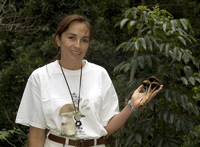 | Dra. Laura Guzmán-Dávalos. UNIV. de GUADALAJARA (MEXICO). My research is on systematics of macrofungi. Currently, I am working with the phylogeny of Gymnopilus (Basidiomycota, Agaricales), and with my Doctoral students the infrageneric relationships of the genera Helvella (Ascomycota), and Psilocybe (hallucinogenic mushrooms, Agaricales), with morphological and molecular characters. |
 | Larry Jimenez Ferbans. INECOL (XALAPA). My research interest focuses on the systematics and biogeography of Scarabaeoidea, especially the bess beetles. In my doctoral thesis, I am intending to elucidate the phylogenetic relationships of the tribe Passalini (Coleoptera: Passalidae) employing morphological and molecular data. |
 | Dra. Sabina I. Lara Cabrera. UNIVERSIDAD MICHOACANA (MORELIA). My main interest is at the species level on the species borders and their relationships, using phylogenetic inference. The taxonomic group I have been focusing is Salvia, particularly the Mexican Salvias to eventually generate a monograph for the group. Since the Mexican species are more than 300 and the basic knowledge such as species identification, typification and collection is not ready yet; I have been focusing on smaller clades and sections sensu Epling and a preliminary molecular phylogeny. Amongst all the imaginable problems I have found in Salvia is the reduced polymorphism in chloroplast and nuclear sequences, analytical difficulties such as excessive computational requirements, phylogenies with suboptimal trees among others. |
 |
José E. López Contreras. CICY (YUCATAN). Me encuentro cursando el Doctorado en Ciencias Biológicas en el Centro de Investigación Científica de Yucatán (CICY) con el tema “Relaciones Filogenéticas en la alianza Pithecellobium (Leguminosae: Mimosoideae) en base a evidencia morfológica y molecular”. |
 |
Denis Jacob Machado. UNIVERSIDADE DE SAO PAULO (BRAZIL). My Master's dissertation project regards the phylogenetic relationships of tapeworms that parasitize Neotropical freshwater stingrays. My main goal is to provide a robust phylogenetic hypothesis that could be useful for the study of host-parasite associations and to understand the diversification of freshwater stingrays. To address this problem, phylogenetic analyzes are performed under Direct Optimization of molecular data via POY. My research interests includes Phylogenetics and Bioinformatics. |
 |
Andrés Martínez Aquino. I. BIOLOGÍA, UNAM (MEXICO DF). My PhD research project is focused on a phylogenetic approach of the freshwater fish digenean genus Margotrema, which are specialist helminth parasites of freshwater fishes of the subafamily Goodeinae (Cyprinodontiformes: Goodeidae) endemic to central Mexico. My research project involves the use of geographic distribution, geometric morphometrics, and nuclear and mitochondrial DNA sequences. I am particularly interested in combining molecular and morphometric phylogenetics as well as using phylogeographic tools to understand the mechanism, process and patterns of evolution of the aforementioned host-parasite association. |
 |
Sandra Ospina Garcés. I. BIOLOGÍA, UNAM (MEXICO DF). I am studying the evolution of the piscivory in the bat genus Myotis. This genus includes piscivorous and insectivorous bats and a great diversity in ecology and foraging strategies, representing an ideal scenario for evolutionary questions, such as how dietary groups evolved in this taxa. I am analyzing morphological variation of geometric conformations of skulls, jaws and wings of several Myotis species. Additionally, I have Cyt B sequences and biomechanical data related to bite. I am interested in reconstructing the phyllogeny of the genus and the correlation of morphological characters and diet. |
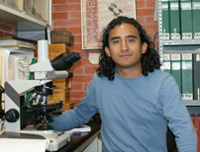 |
Ricardo Paredes. I. BIOLOGÍA, UNAM (MEXICO DF). My main interest is the systematic of parasitic mites and the coevolution with its hosts. Now, I am finishing my Ph.D. research project about the phylogenetic relationships among the genera of Pterygosomatidae (Acari: Prostigmata), mites associated to lizards, analyzing morphological and molecular data and, additionally studying the evolution of the parasitism in these mites. |
 |
Hugo Alexandro Peña Vázquez. INECOL (XALAPA). My actual research in the MS degree program is related to construct the hypothesis about the phyllogenetic relationships of the genus Diplotaxis Kirby (Coleoptera: Scarabaeidae) based in morphological characters of adult specimens. |
 |
Marcia Ramírez. FAC. CIENCIAS, UNAM (MEXICO DF). My ongoing PhD Thesis aplies geometric morphometric analyses of some Mexican species of Megaluracarus (a water mite subgenus) to describe shape quantitatively and to provide characters of taxonomic value to current descriptions.Morphometric characters will be included in a phylogenetic analysis to propose evolutionary hypothesis in this group of water mites. I also have experience in some ecological aspects of the group, such as mating behavior, which certainly allows me to supplement or discuss the results from my morphometric and phylogenetic analyses. |
 |
José Martín Ramírez-Ortega. INECOL (XALAPA). My doctoral research addresses the Systematics of Cribrariaceae, a cosmopolitan family of Myxomycetes. Among all Myxomycetes this is the only group that develops a peridal net and plasmodic granules. I am reconstructing their phylogenetic relationships based on morphological characters, including SEM observations of the spore surface ornamentation. |
 |
Jesús Alexander Rodríguez A. UNIV. de COSTA RICA (COSTA RICA). I am interested in the biogeography and phylogeography of microscopic insects, particularly groups of thrips and collembolan. Currently, I am working the biogeography of thrips, especially with the Neotropical genus: Frankliniella (Fam. Thripidae). One goal of my research is focused on the systematic history of this genus with data from morphology, molecular and geographic information of their species in Costa Rica. By this way, it could be acquired the most complete scenario of changes and disjoints in their systematic and distributional patterns. Also, I am fully interested in new methodologies in phylogeny reconstruction with morphological data using electron microscopy and confocal microscopy in Costa Rica. |
 |
Pedro Romero. UNIV. NACIONAL MAYOR de SAN MARCOS (PERÚ). My work is focused on phylogenetics and phylogeography of land snails from Peru. I studied intraspecific variation and the influence of the habitat and climate changes on the genetic structure of land snails from the Peruvian coastal desert and Amazon. Now, I am studying the phylogeny and historical biogeography of Orthalicoidea, a highly diverse group in the Neotropics. |
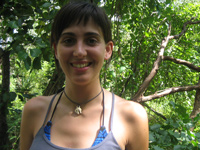 |
Aida Verdes. UNIV. AUTÓNOMA de MADRID (ESPAÑA). My research focuses on the systematics of the genus Odontosyllis (Annelida, Syllidae) aiming to solve part of the systematic flaws concerning this intriguing group of marine polychaetes. I am currently developing a phylogenetic revision of the genus and working on a new proposal of classification based on a cladistic methology. My research interests also involve the bioluminescent properties some Odontosyllis and other related species of polychaetes (i.e. several Eusyllis spp.) show during the reproductive stage. |
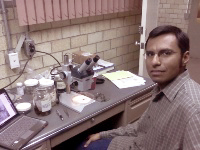 |
Javier Víctor. ZOOLOGÍA, ENCB, IPN (MÉXICO). My main research interest is the systematics of bark beetles and weevils. My work has been focused mainly on elucidating the phylogeny of Dendroctonus bark beetles and on species delimitation within this genus. In addition, I have started studying cossonine bark weevils, a largely neglected group of weevils which has not been examined in a phylogenetic context, and currently developing a protocol for a Ph.D. thesis project oriented to revisionary and phylogenetic work on this group (particularly on the speciose genus Cossonus), based primarily on morphological data but with the purpose of eventually incorporating molecular data as well. |
 |
Ana Wegier. I. ECOLOGÍA, UNAM (MEXICO DF). I am at the end of my PhD studies, which revolved around the microevolution of plants, specifically, genetic structure and gene flow of wild cotton (Gossypium hirsutum) in Mexico. My principal interests at this moment are researches about the centers of origin, domestications and genetic diversity of some crop plants, and the strategies based in filogenetic analyses and conservation genetics. |